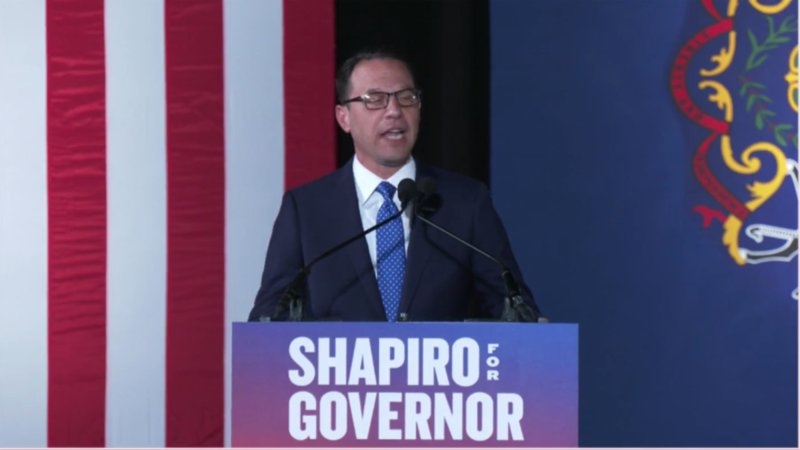The Shapiro Effect: Were there coattails for down-ballot Pa. Dems? | Monday Morning Coffee

(*This post was updated at 7:47 a.m. on Monday, 11/21/22 to include additional reporting on the role redistricting played in helping Democrats retake the state House.)
There’s little doubt that Democratic Gov.-elect Josh Shapiro rang up some big numbers in his 14-point trouncing of Republican Doug Mastriano on Election Day.
But did the two-term attorney’s general decisive victory benefit such down-ballot candidates as U.S.-Sen-elect John Fetterman, congressional hopefuls, and the legislative candidates who helped Democrats recapture the state House after 12 years of Republican rule?
That’s the narrative that Shapiro’s campaign was shopping to political journalists around the state last week as they touted the indisputably impressive 3 million votes the two-term attorney general tallied in his 56-42 percent win over Mastriano.
“Josh’s historically strong performance held in counties across the Commonwealth where Democrats often struggle,” the campaign said in a statement, noting that Shapiro now holds the record for nabbing the most votes in both a midterm and presidential cycle.
“Throughout his career and campaign, Josh vowed to show up and listen to all 67 counties and the results are proof of his work,” Shapiro’s campaign said in an email blast to reporters last week.
But again — was that enough to pull other Democrats over the finish line? The answer, as they say, is complicated. We’ll explore it below.

Historically, Pennsylvania’s top of the ticket candidates usually do not have coattails. Former Gov. Ed Rendell won big in his first campaign in 2002, but that was not enough to recapture the state House.
Democrats barely recaptured the House during Rendell’s second campaign 2006, and they were promptly swept out of office in the 2010 Tea Party wave. Ditto for Gov. Tom Wolf, who won in his two campaigns in 2014 and 2018, but who did not secure legislative majorities.
And in 2020, President Joe Biden carried the state on the way to the White House, but it also was not enough to bring other Democrats with him.
People close to Shapiro’s campaign noted that the Democratic nominee’s high favorables allowed down-ballot hopefuls to hitch themselves to his political fortunes — an unusual move when you consider that Democrats were expected to take a beating in a year that was putatively unfriendly to Biden.
In fact, Shapiro filmed ads supporting a half-dozen Democratic House candidates, including Melissa Cerrato, whose razor-thin win over incumbent state Rep. Todd Stephens, R-Montgomery, last week handed the Dems their precarious majority in the lower chamber.
*But there are three big reasons why both Shapiro and Fetterman managed to forge a connection with voters, and with that, bring along other candidates, including the three, competitive congressional seats that were denied to Republicans.
One of them was Mastriano, whose right-wing extremism was galactically unpopular with huge swaths of voters, and GOP U.S. Senate nominee Mehmet Oz, a New Jersey native, whom Fetterman effectively tarred with the ‘carpetbagger’ brush early in the campaign — thanks to some relentless trolling.
“I think there is a consensus that Republicans could not run away from Doug Mastriano at the top of the ticket. And Democrats did exceptionally well with Josh Shapiro at the top of the ticket,” Mustafa Rashed, a Democratic consultant from Philadelphia, told the Capital-Star.
Shapiro was a “centrist candidate from a centrist state, and when your opponent is not doing that, it’s a clear contrast,” Rashed continued.

*Democrats also were the beneficiaries of redrawn legislative maps that leveled the playing field, allowing them to compete in districts where they were not previously competitive.
“Pennsylvania voters rejected, overwhelmingly, fear. Pennsylvania voters overwhelmingly rejected hatred. Pennsylvania voters overwhelmingly rejected division,” Rep. Joanna McClinton, D-Philadelphia, who oversaw the remapping for House Democrats, said. “And the fact that it’s here in the birthplace of our nation and the birthplace of our democracy, it is much more than symbolic that we will finally have a woman that has the gavel in the Pennsylvania House.”
There’s also little doubt that the rage over the U.S. Supreme Court’s June ruling toppling Roe v. Wade earlier this year energized not only the Democratic base, but also younger voters and independents, effectively neutralizing GOP doomsaying over the economy and public safety.
“Young people cared about a woman’s right to choose – those were hardcore driving factors,” Rashed said. “Doug Mastriano was a rallying cry about the worst that could happen to Pennsylvania.”
University of Pittsburgh political analyst Lara Putnam amplified the analysis, telling the Capital-Star that “the fairest thing to say about Shapiro and Fetterman is that the two of them together were really a dream team in terms of making the pitch to swing voters and independent voters in [Pennsylvania], with both [of them] embracing very broadly popular positions on abortion, union rights, fracking, and so on.”
Had Fetterman faced ex-hedge fund magnate David McCormick, who lost the GOP nomination to the Trump-endorsed Oz, the dynamics of the nationally watched U.S. Senate campaign might have been entirely different, observers said.
The same holds true for the gubernatorial contest, where former U.S. Rep, Lou Barletta, of Hazleton, and outgoing state Sen. Jake Corman, R-Centre, both more traditional conservatives, mounted failed bids for the GOP nomination.
In the end, however, neither was able to overcome Mastriano’s popularity among a certain segment of the Republican grassroots.
But the Trump-endorsed Mastriano, who trafficked in election denialism and Christian nationalism, struggled to both raise money and to expand his coalition, which meant he could not build the broad-based support he needed to pose a credible threat to Shapiro.
“Mastriano was significantly underfunded and was a fringe candidate from the start, while the [Pennsylvania] Senate race was the most expensive in the country,” Commonwealth University-Mansfield political science professor Jonathan C. Rothermel told the Capital-Star. “Despite a poor debate performance, Fetterman’s ‘every county, every vote’ campaign, relentless social media attacks, and his relative authenticity paid off.”
In the end, “there’s no way to distinguish between Mastriano’s underperformance and Shapiro’s overperformance when we are analyzing vote totals,” Pitt’s Putnam said.
The bottom line is that both Democratic candidates “were able to convince voters together that their GOP opponents were dangerous and out of touch with real Pennsylvanians’ values and priorities,” Putnam continued.
So did that add up to coattails for down-ballot Democrats? According to Putnam, the answer is “yes.”
“Voters across a pretty wide ideological spectrum responded by showing up in very strong numbers to choose Democratic candidates up and down the ballot,” she said.








